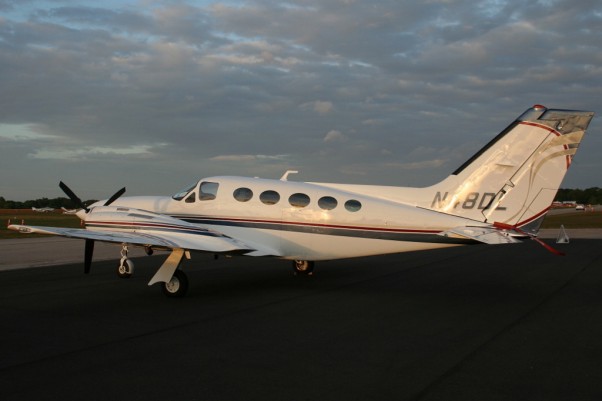While it will take months or years to find a definitive cause of the crash of the Cessna 421 that went down in the Gulf of Mexico on Thursday, initial evidence may indicate that the pilot lost consciousness due to pressurization issues.
The Cessna 421 has a pressurized passenger cabin, allowing it to fly at altitudes up to 30,800 feet. Because of the lack of oxygen at higher altitudes, non-pressurized aircraft, such as the smaller but more popular Cessna 172, are relegated to altitudes at which people can breathe without mechanical help, maxing out at around 10 to 12,000 feet.
According to published reports, the crews of two F-15 fighter jets scrambled by NORAD to intercept the plane said that the Cessna’s windows were iced over, a common sign of pressurization problems.
Thursday’s flight plan for the crashed plane, N48DL, called for a 27,000 ft cruising altitude, which it had reached when it began circling out of control about an hour into its flight over the Gulf of Mexico. According to an aviation safety expert who spoke on the condition of anonymity due to the ongoing investigation, a pilot would have about 10 seconds to put on an emergency oxygen mask before passing out if the plane suddenly lost pressure at that altitude.
That equation varies greatly, however, depending on the speed of the leak, the presence of pressure alarms in the aircraft, and the unique physiology of the pilot. In the case of a slow leak, many pilots will develop an extreme euphoric feeling and might not be able to rationalize what is happening. A minority of pilots might come down with altitude sickness before losing their faculties, with nausea and headaches signaling to them that something is wrong. And a pilot who smokes or in poor health has even less time to react before passing out.
A pressurized cabin is only as good as its weakest link, and there are a number of potential failure points in each one. The most obvious culprits are a broken window, a crack in the fuselage or a door seal. The outflow valve, whose main purpose is to regulate the pressure in the cabin, is another potential failure. There are also a number of sealed openings in the cabin through which control cables and wiring for the flight surfaces and engines pass, and the failure of even the smallest, most arcane of these can cause major problems. Malfunctioning engine turbochargers, from which the interior pressure is generated, can also cause a loss of pressure, though such a malfunction in the engine would also likely cause a loss of altitude, which did not occur in this incident.
While aerospace engineering has evolved to a point that incapacitating pressurization accidents are rare, there have been some tragedies in recent years:
- In 2005, Helios Airways Flight 522, a Boeing 737-300 flying from Lanarca, Cyprus, to Athens, lost contact with air traffic controllers over the Mediterranean shortly after the pilots reported an air conditioning problem. F-16s scrambled to investigate found the pilots were unconscious, but there was nothing to be done. The jet ran out of fuel over southern Greece and crashed into a mountain, killing all 121 people onboard. The culprit is determined to have been an incorrect pressure setting by the crew.
- Pro golfer Payne Stewart and five others were killed in 1999 when the Learjet they were flying from Orlando to Dallas lost pressure and flew out of control until running out of fuel over South Dakota. Investigators were unable to determine the exact cause of the pressure loss.
- Susan Reynolds, a candidate to become a NASA astronaut, and another pilot, were flying a Lear 24B from Memphis to Addison, Texas, in 1988, when they lost contact with controllers, flew uncontrolled into Mexican airspace, and crashed after running out of fuel, killing both onboard.
Editor’s Note: A sobering reality of aviation safety is that it evolves primarily as a result of prior failures. It may seem a bit soon to speculate on the cause of this accident before we even know the condition or identity of the pilot. But even if the speculative parts of this article are eventually proven incorrect, we hope that it will at least remind safety professionals everywhere of the importance of checking and double checking everything.







